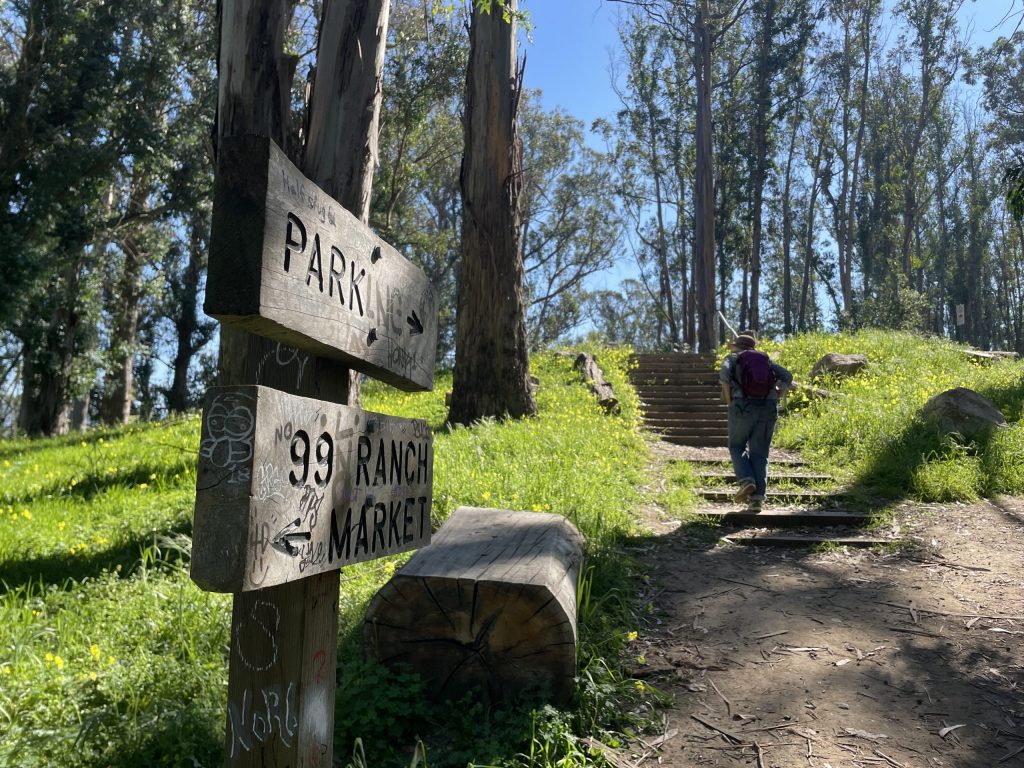
From the 338-foot summit of Albany Hill, Margot Cunnigham surveys sweeping vistas of the Golden Gate, Oakland, the East Bay hills, Mt. Tamalpais, and beyond.
“So many people don’t know about this place,” says Cunningham, the city of Albany’s natural areas coordinator since 2017. “You look up while driving by and see this green thing, and don’t realize that there’s a park here.”
Located between busy San Pablo Avenue and the El Cerrito Plaza mall to the east and even busier Interstate 80 and Pacific East Mall to the west, Albany Hill is an ecological island amid urbanity at the edge of the San Francisco Bay. More than 100 native plants, 150 moths and butterflies, and 100 bird species have been spotted here, as well as a native scorpion. Willows grow along the banks of Cerrito Creek to the north and a mature forest of coast live oaks flanks its east side. The summit is crowned by some 1,000 non-native eucalyptus.
It’s Cunningham’s job to help coordinate all things Albany Hill. For the past decade, Albany — a city of 20,000 between El Cerrito and Berkeley — has been implementing its 2012 Albany Hill Creekside Master Plan, which includes accessibility upgrades, fire safety measures, and the preservation of native plant communities and important overwintering sites for monarch butterflies.
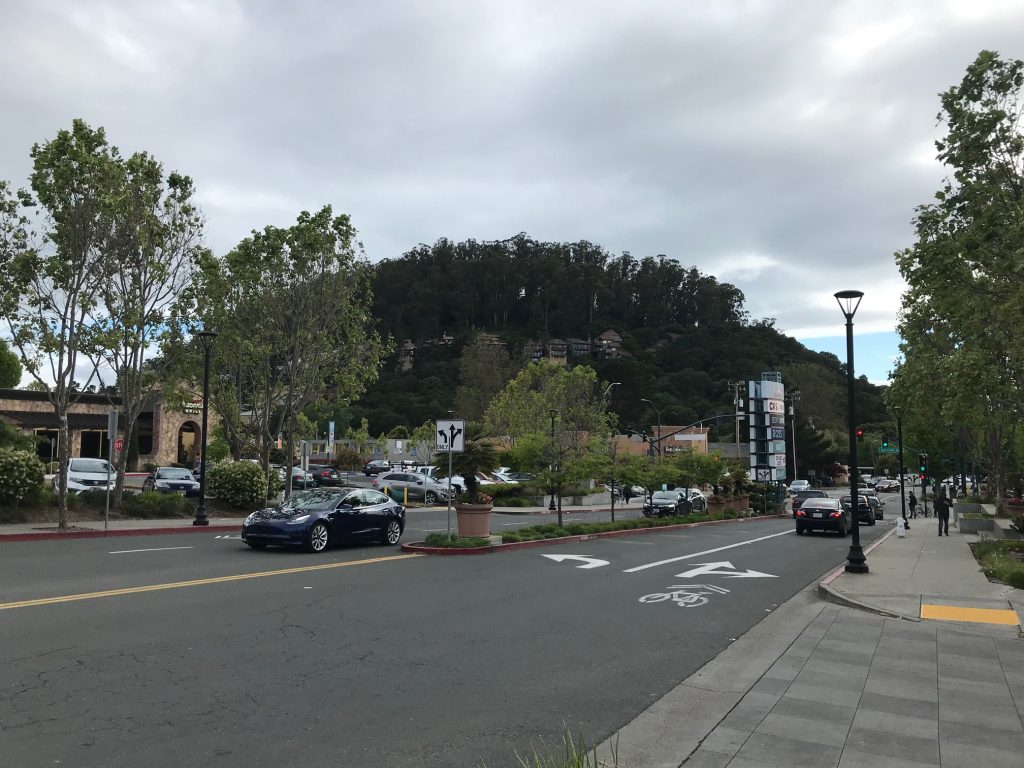
To circumambulate Albany Hill – a 2-mile, 1-hour walk –start at the Peet’s on the corner of San Pablo Avenue and Carlson Boulevard; the starting point is 0.4 mile from the El Cerrito Plaza BART station and on the 72 AC transit line. Walk west past the Old Gun Room and bear left onto Adams Street to Cerrito Creek Path West, with recycled-glass paving
Two Counties, Two Cities, One State, One Creek
El Cerrito – which means “the little hill” in Spanish – takes its name from a hill in Albany. Cerrito Creek forms the border between Albany and El Cerrito, as well as Alameda and Contra Costa counties. Discussions are underway to build two bridges across the creek, a challenging proposition because of the multiple jurisdictions involved, including a small portion owned by the State of California’s Orientation Center for the Blind.
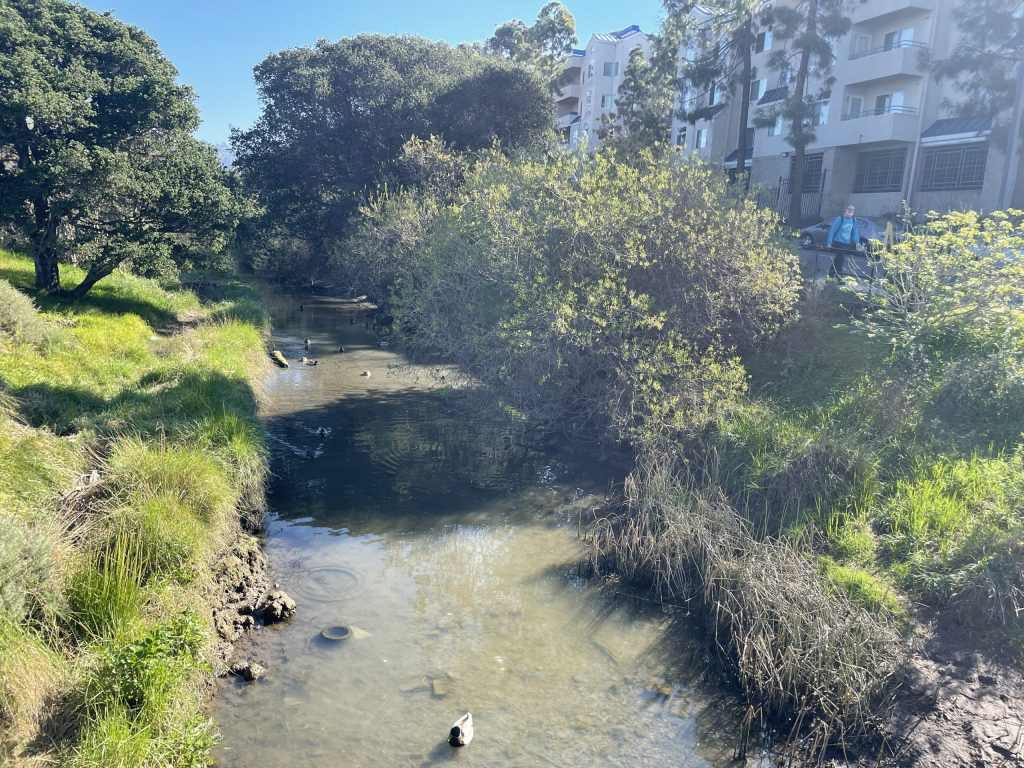
Walk along the path through Creekside Park in El Cerrito, passing Pacific East Mall on the right (in an area that was quarried for many years), until you reach Pierce Street, keeping an eye out for families of mallards and other waterfowl in the wetlands.
If You Lived Here, You’d Be Home By Now
Turn left, cross over Cerrito Creek on Pierce Street, and walk back on the creekside trail on the Albany side. There are hundreds of homes on Albany Hill, including the high-rise towers on Pierce Street in front of you; multifamily housing with terrific views to the east; and single-family homes on the less steep portions to the east and south.
Turn left, cross over Cerrito Creek on Pierce Street, and walk back on the creekside trail on the Albany side. Continue along the creek and follow the trail until it branches off to the right.
The Huchiun Way
Just beyond the trail turn-off, keep an eagle eye out for mortars in the large, flat rocks on both sides, which the Huchiun band of Ohlone used for pounding acorns, grass, and wildflower seeds. The Huchuin lived along the creek and its tributary here for thousands of years, and flecks of shells from their middens can be seen in the soil along trails.
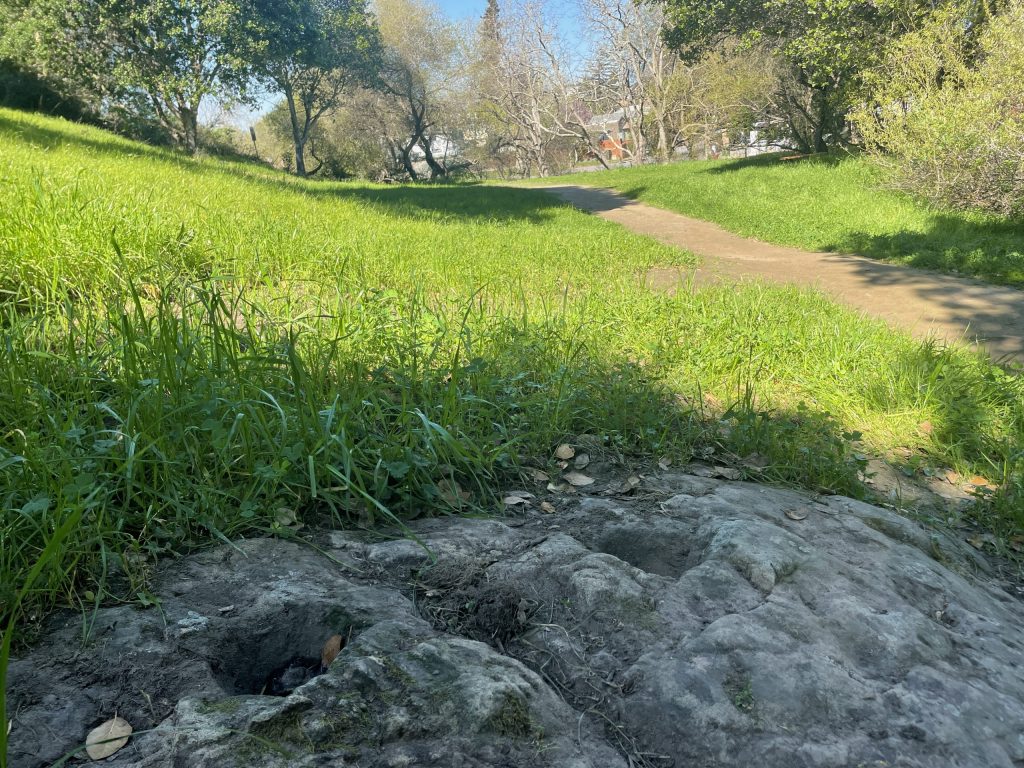
A short distance Past the mortars, turn right on the first trail you see to start climbing the hill.
Oaks Among Us
While walking up through the mature oak forest, be grateful to all the East Bay residents who have fought various ill-advised development schemes on Albany Hill since the 1940s, including construction of a 17-million-square-foot PG&E water storage tank; removal of 200 feet from the hilltop to build 300 homes; and a scheme for a luxury hotel with 527 rooms, a convention center, 3 bars, and a swimming pool,
Spurred by the committed stewardship efforts of Friends of Albany Hill, Albany began acquiring the land to create Albany Hill and Creekside Park in the 1990s. These days several local volunteer groups advocate for the park and tend Albany Hill’s natural areas: Friends of Albany Hill works to preserve native species and supports the annual monarch butterfly migration; Friends of Five Creeks restores habitat along the creek banks and hillsides; El Cerrito Trail Trekkers regularly fishes trash out of the creek; and Cunningham’s group, Tending the Ancient Shoreline Hill (TASH), pulls invasive plants to allow natives to return and supplements with native plantings.
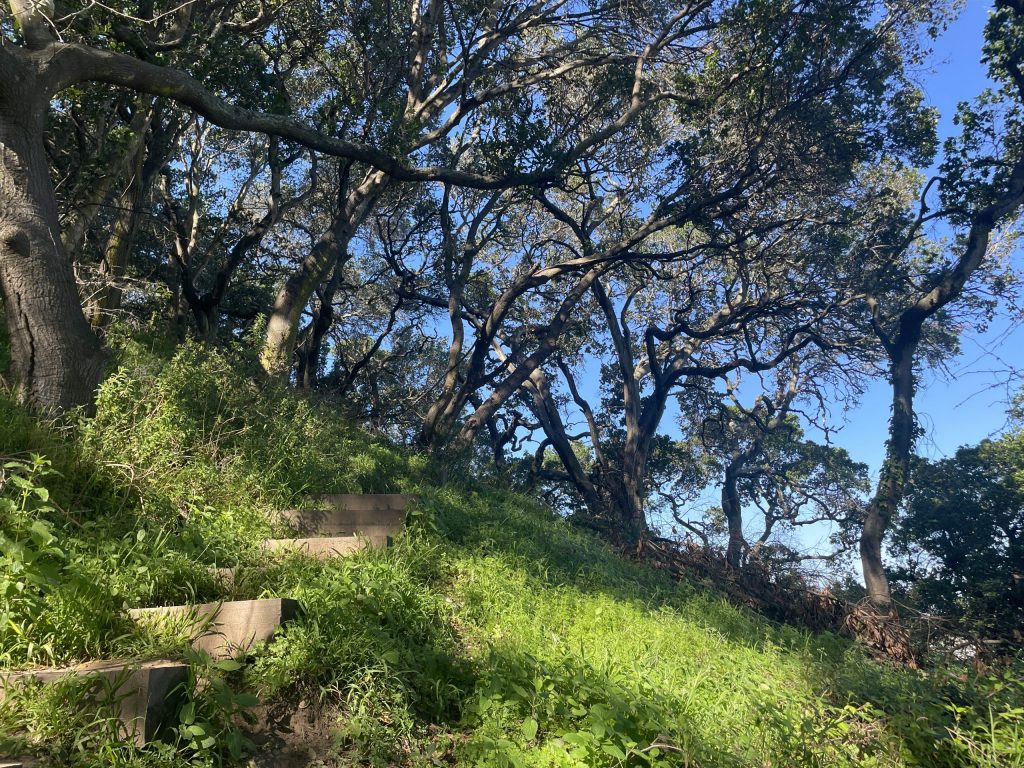
Follow the trail and continue up a new set of stairs to where Jackson Street ends. Continue up the stairs to the right and follow the trail to the main park -entrance on Taft Street.
Summit Access For All
Continue up the stairs to the right and follow the trail to the main park -entrance on Taft Street. In 2020 Albany completed a 482-foot, ADA-compliant cement trail from the uppermost park entrance on Taft Street. Benches with wonderful views dot the summit area, as well as a few renegade swings.
Recently completed trail improvements include regraded trail and 100 new steps at the park entrances at Taft, Jackson, and Madison streets on the hill’s south side. “The city wants to increase access for more people,” Cunningham says.
With the help of the Richmond nonprofit Urban Tilth, Albany is continuing improvements by installing additional steps, decommissioning switchback cutoffs, and shoring up eroding areas of trail; plus local Eagle Scouts are planning additional trail projects.
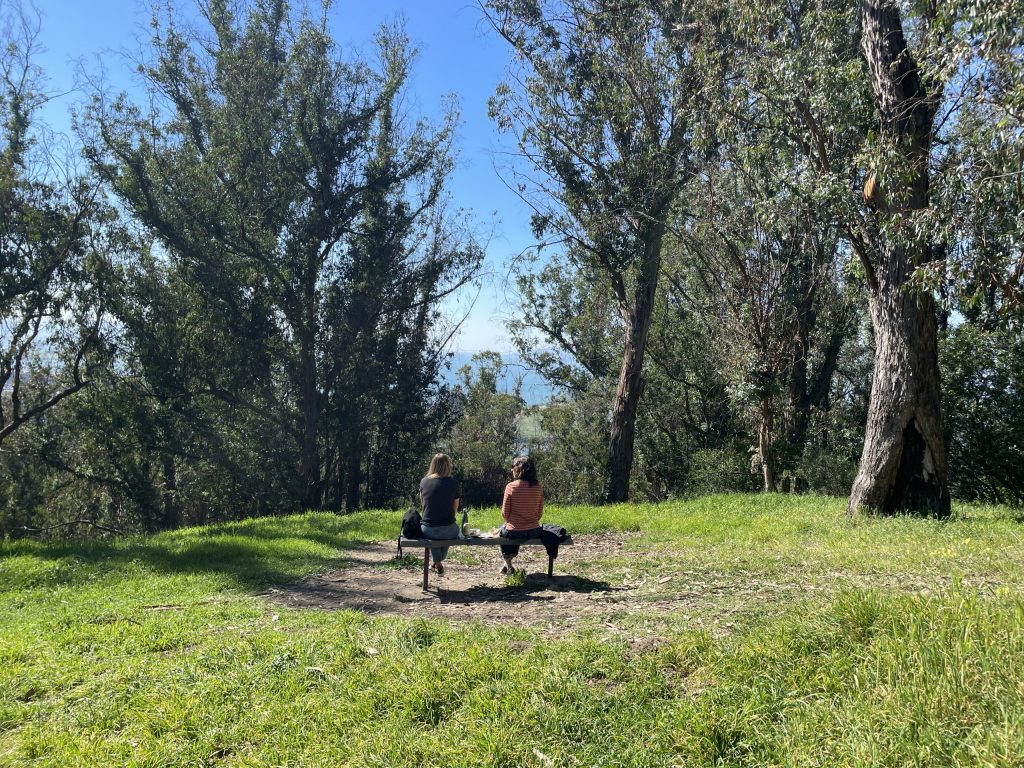
When you see the Albany Hill Park sign at the end of Taft Street, take the cement trail to the circular sitting area at the summit.
Monarchs and Eucalyptus
The tall eucalyptus on Albany Hill — which were planted in the late 19th century as a buffer for dynamite and gunpowder factories on the northwest side — are now suffering from leaf blight fungus, and they present a fire danger to surrounding residents.
“The trees can’t photosynthesize and make enough energy to survive,” Cunningham says. “Plus climate change and the warmer, drier climate is affecting them in a way that they won’t be able to make it.”
To limit fire danger, Albany has installed a new fire hydrant at the summit and hired Urban Tilth to mow annual grasses and remove bark and branch debris, as well as a tree company to remove dead eucalyptus. Staff from the Albany Fire Department and others inspect Albany Hill daily.
Monarch butterflies have used the hill’s eucalyptus as overwintering sites in significant numbers, Cunningham says, although the counts were alarmingly low this year. Albany has been consulting with arborists and scientists to figure out how to remove the hazardous, diseased trees and restore native habitat for the monarchs, which will involve protecting native understory and planting trees for them to overwinter in.
“Most of the people I talk to don’t like the eucalyptus,” Cunningham says. “But we have to make sure that we do the tree removal in a responsible way.”

Walk downhill toward the white cross, taking time to admire the views in all directions.
A Cross to Bear
As you start making your way down the hill, it’s hard not to miss the 20-foot cross on the left, which was erected by the Albany Lions Club in 1971. The site was obtained by the City of Albany in 1973, and wrangling over the legality of the religious symbol on public land ensued for the next 50 years.
Farther down the hill, an 11-acre, unfenced tract on the west side is privately owned and remains zoned for residential development; the owners are currently asking $10 million for the property.

Bear left at the bottom of the hill and take the stairs to Taft Street. Cross over and walk down Hillside Avenue, cross Cerrito Street, then take the staircase on the right to Jackson Street. Continue straight onto Castro Street, then turn left on Madison Street and walk to the end.
A Tributary Runs Through It
Reenter Albany Hill Park, noticing the new stairs, native plantings, and plank bridge over a gully that drains into Middle Creek. The tributary disappears into a culvert under the Orientation Center for the Blind, then winds through dense willows before flowing into Cerrito Creek.

When you reach Cerrito Creek, continue down the short path to where a tree provides solid footing for those with good balance, or walk back to Pierce Street on the Albany side and return the way you came on Cerrito Creek Path West.
Photos: Janet Byron

